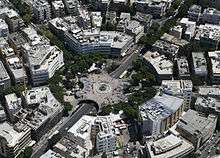Dizengoff Square
Coordinates: 32°04′41″N 34°46′27″E / 32.07806°N 34.77417°E

Dizengoff Square or Dizengoff Circus (Hebrew: כִּכָּר דִיזֶנְגוֹף, fully Zina Dizengoff Square, Hebrew: כִּכָּר צִינָה דִיזֶנְגוֹף, Kikar Tsina Dizengof) is an iconic[1] public square in Tel Aviv, on the corner of Dizengoff Street, Reines Street and Pinsker Street. One of the city's main squares, it was built in 1934[2] and inaugurated in 1938.[1]
History
Early history (1930s-70s)

The square, built in 1934, was part of the original urban plan by Sir Patrick Geddes, and was designed by architect Genia Averbuch. The idea to build a parking lot under the square went unrealized, and instead a roundabout was fashioned around the square, at its center a garden with a fountain and shady seating areas.[2] For decades the square was a popular location and one of the landmarks of Tel Aviv's historic "White City."[2]
The square is a circular plaza and has been a focal point of Tel Aviv since its establishment in the 1930s,[3] its location in the very heart of Tel Aviv being one of the reasons.[4] Dizengoff Square is named for Zina (Tzina), the wife of Tel Aviv's first mayor, Meir Dizengoff. Its original 1930s design was called "the Étoile of Tel Aviv" due to the form of the square - a roundabout at the meeting of six streets.[4]
Redesign (1970s)

In 1978, however, the current split-level configuration was introduced, during Shlomo Lahat's tenure as mayor, with Dizengoff traffic flowing beneath it.[2] The plan was by architect Tsvi Lissar, of Lissar Architects and City Planners.[5] It was elevated in an effort to ease congestion in the area.[1] The square was rebuilt using an entirely different design: the square was covered with an elevated pedestrian plaza above Dizengoff Street, Pinsker Street and Reines Street.[4] The pedestrian area is elevated, connected by ramps to the adjacent sidewalks and to the pedestrian areas of Ben Ami and Zamenhoff streets, while traffic uses the lower level.
The changes met with furious reactions, but the city authorities explained at the time that these were necessary to solve traffic problems.[2]
Center and fountain (1980s)
The square stands 300 metres (980 ft) from Dizengoff Center, construction of which began in 1972 and was not completed until 1983. A fountain was erected in the middle of the square during its redesign in the 1970s, and was replaced in 1986 with Yaacov Agam's now landmark kinetic sculpture fountain.[2] The current fountain is located in the center of the elevated plaza.
Redevelopment (2000s)
There are proposals however to return Dizengoff Square to its original state in order to restore its popularity.[4] In 2007, Tel Aviv's municipal engineer, Hezi Berkovich, explained how they wanted to "avoid split-levels, raised or sunken, in the center of town, and currently the square cuts off the line of sight that is so important for pedestrians, who do not walk along the street sidewalks and do not enjoy them. They simply go up and down at the square. Over the years, the square and the houses surrounding it deteriorated together".[2] In addition, they would want to move Agam's sculpture elsewhere in Tel Aviv.[2]
Former Mayor Lahat, who was mayor when the redesigned square was brought in, also favours restoring the square to street level, saying that destroying the original square to solve congestion was the one mayoral decision he regretted.[2] He said that, "I am responsible, and I take the blame," and that "we changed the square, and all the greenery, the beauty and the pleasantness went. Now it is possible to do something really beautiful and impressive," referring to the potential redevelopment of the square.[2]
Restoration (2010s)
In 2012, the fountain was restored, freshly painted and repaired.[6] In addition, the blue benches were repainted blue.
Redesign (2016s)
in 2016 Tel Aviv municipality decided to bring the square back to it's original design and move it back to the street level, causing a public controversy. [7]
Activity
Audio guided tours around the square are offered by Bauhaus Center. Twice a week, a second-hand market takes place at the bottom level.
The beis medrash (synagogue/study hall) of the Koidanover Rebbe, Rabbi Yaakov Tzvi Meir Ehrlich, is located in Dizengoff Square. This beis medrash serves as an outreach center where weekly lectures and a Friday-night Oneg Shabbat attract many secular Jews and guide them towards religious observance. The Koidanover Rebbe is well known as an inspiring speaker and educator.[8]
In popular culture
- Matt Harding chose Dizengoff Square and Agam's fountain to film his worldwide dance, Where the Hell is Matt?, on June 28, 2007 (the film was released in 2008, and is available here).[9]
References
| Wikimedia Commons has media related to Dizengoff Square. |
- 1 2 3 Architect vows to fight municipal plan to raze iconic Dizengoff Square, Haaretz, Yigal Hai, August 15, 2007
- 1 2 3 4 5 6 7 8 9 10 Turn back time and retrieve Dizengoff Square, Haaretz, Yigal Hai
- ↑ Dizengoff Street, Encyclopædia Britannica
- 1 2 3 4 Tel Aviv, Frommer's
- ↑ Squares in a round hole, Haaretz, Shani Shiloh
- ↑ Israel’s Most Famous Fountain Is Back In Use 2012
- ↑ http://www.haaretz.com/israel-news/.premium-1.723598
- ↑ Bernstein, Dovid (2 November 2009). "Koidenover Rebbe in Queens Tonight". matzav.com. Retrieved 21 June 2012.
- ↑ Where the hell is Matt? In Israel, Ynetnews, Adar Shalev, June 25, 2007